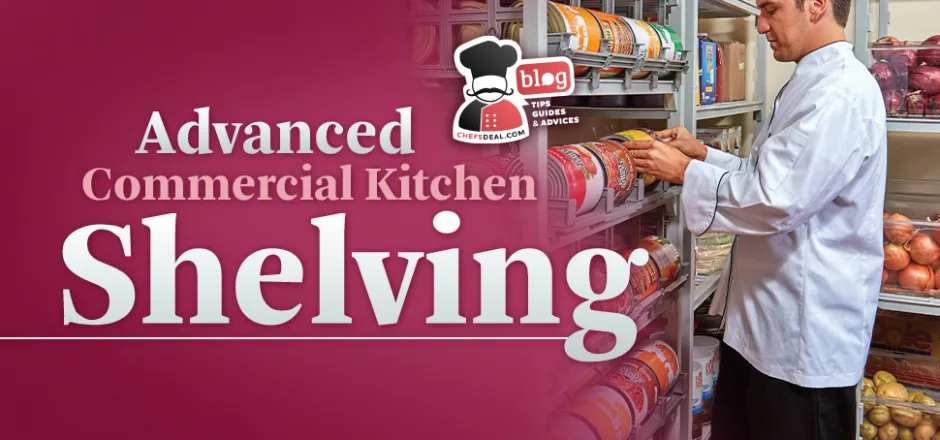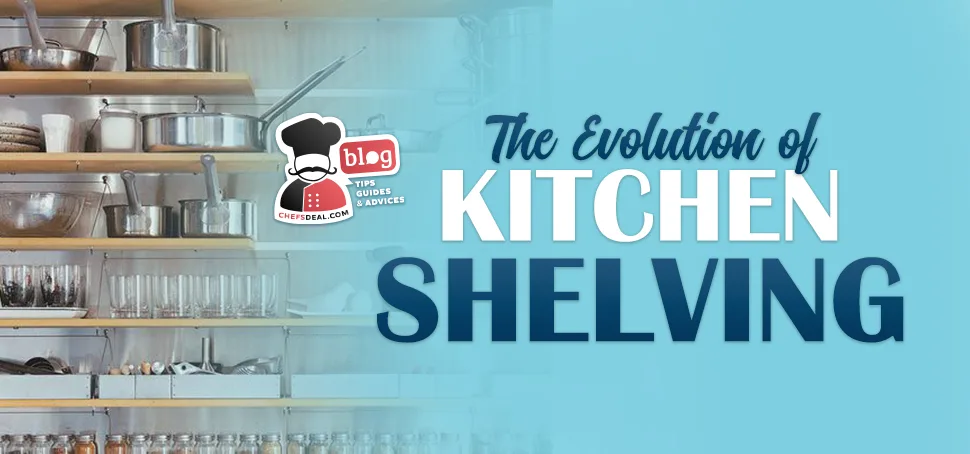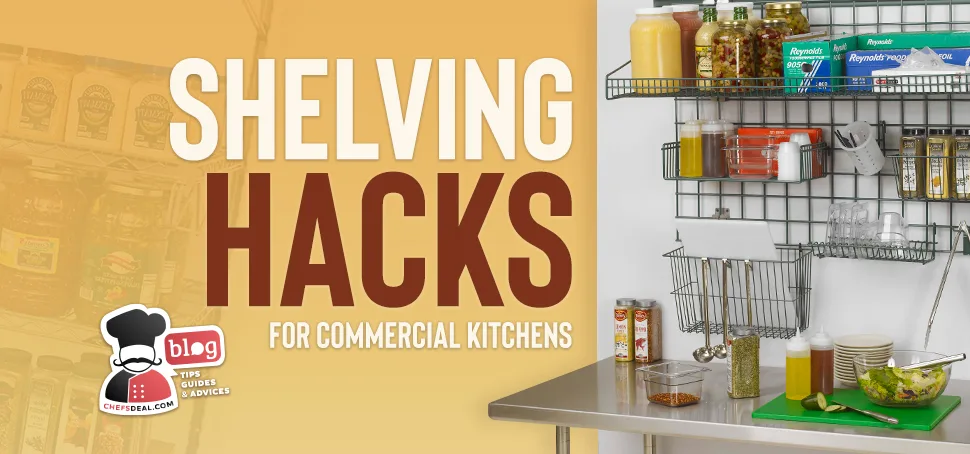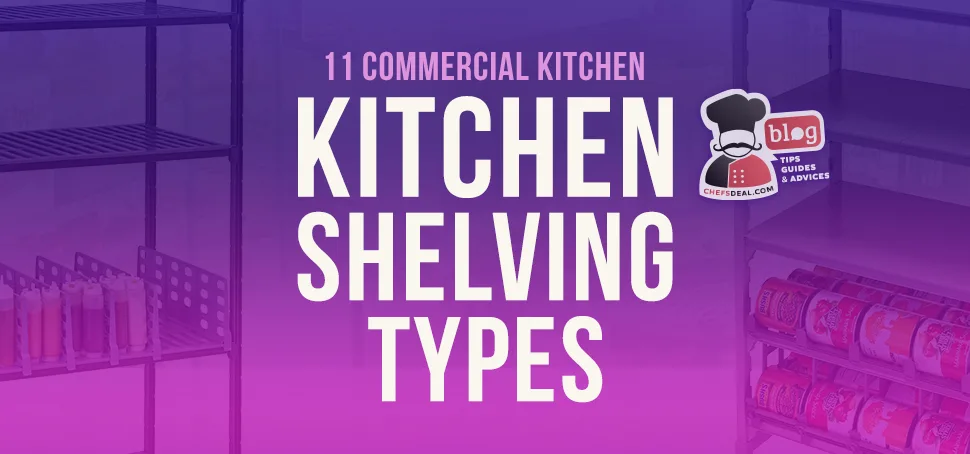Advanced commercial kitchen shelving refers to shelving systems incorporating modern design elements, innovative materials, and smart technology to enhance functionality, efficiency, and customization in commercial kitchen environments.
These systems often include adjustable heights, modular configurations, and temperature control mechanisms. They may also be equipped with IoT (Internet of Things) capabilities for inventory management, allowing real-time tracking of stock levels, expiration dates, and even automated reordering processes. Materials used in advanced shelving are designed for durability, ease of cleaning, and compliance with hygiene standards, including stainless steel, antimicrobial coatings, and eco-friendly options like bamboo.
From the implementation of IoT for dynamic inventory management to the ergonomic benefits of automated shelving systems, advanced shelving solutions are tailored to meet the specific needs of diverse food service operations, from high-volume restaurants and hotels to hospitals and educational institutions, ensuring optimal space utilization, food safety, staff well-being, and operational workflow.
Commercial kitchen shelving is experiencing a transformative shift, propelled by integrating smart technologies and innovative design solutions. Modular shelving solutions offer unmatched flexibility and customization, accommodating the evolving needs of commercial kitchens. The move towards sustainable and eco-friendly materials highlights a commitment to environmental responsibility, while hygienic design practices ensure the highest food safety standards. Temperature-controlled shelving further underscores the importance of preserving ingredient freshness and space-saving innovations to maximize kitchen functionality.
As we transition from traditional to modern shelving systems, the emphasis on cost-effectiveness and high ROI illustrates the economic advantages of investing in advanced shelving solutions. Collectively, these developments are reshaping kitchen storage and enhancing the overall functionality, safety, and sustainability of commercial culinary environments.
Integration of Smart Technology in Shelving Systems
Integrating smart technology in commercial kitchens enables commercial kitchen shelving systems to be more than just storage. Inventory management is one of the biggest parts of the food service industry, and it is important to keep the right amount of products on hand for enough stock to serve while avoiding waste at the same time. With IoT and smart shelving, manual inventory counts and tracking are no longer necessary. This reduces staff work and saves valuable time while providing precise inventory data.
The Internet of Things (IoT) is a network that collects data using sensors, software, and similar technologies and exchanges the data with other devices via the Internet, such as commercial equipment interacting and transmitting data to the operator.
IoT provides beneficial data regarding inventory tracking and management. Unlike traditional inventory tracking, which is time-consuming and error-prone, IoT inventory tracking automatizes tracking, predicting demands, and reordering, greatly facilitating processes. Integrating IoT sensors and smart shelving features in commercial kitchen shelving, such as RFID tags and barcode scanners, provides real-time inventory data, eliminating manual tracking, streamlining operations, and improving efficiency.
The integrated sensors in commercial kitchen shelving systems can monitor inventory amounts and temperature inside the shelving, preventing stockouts and overstocking and giving essential information about consumption rates.
Automated Shelving Solutions for Enhanced Efficiency
Automated commercial kitchen shelving solutions facilitate and improve kitchen operations, maximize storage, and enhance efficiency. Automated shelving systems can adjust heights and positions based on real-time kitchen needs. Kitchen ergonomics reduce fatigue and health risks from wrong posture and continuous movement, as well as reaching too high shelves to get something in a kitchen. Innovative pull-down shelving provides a healthy working position, easy access, a better view, and an ergonomic system for the staff.
Automated shelving systems come equipped with varied features for adjusting and moving shelves; for instance, certain models utilize digital buttons for precision control, while others employ levers for manual adjustment. The shelves move downward and upward for easy access and better sight, providing smooth operation and enhancing performance.
Modular Shelving for Custom Configurations
Custom modular kitchen shelving maximizes kitchen space and enhances storage efficiency. Modular designs allow for easy expansion and reconfiguration to adapt to changing kitchen demands. Modular shelving can be customized to fit every kitchen by creating specific areas, making use of every inch, and tailoring to the specific needs of a kitchen.
Modular kitchen shelving can be reconfigured and expanded to meet the changing needs of a kitchen, such as changing the layout, adapting to new equipment, and adding to the kitchen. The designs, sizes, and shapes of the shelving, drawers, and accessories are customized according to preferences. Modular kitchen shelving combines various shelving types, from open shelving to corner cabinets, to meet the demands of different kitchens and offer various options for users.
Eco-Friendly and Sustainable Shelving Materials
Using sustainable shelving materials enables your operation to be eco-friendly and enhances sustainability. It can also create a stylish and functional kitchen design. Commercial kitchen shelving materials are mainly stainless steel, aluminum, polymer, wood, and glass. Advancements in commercial kitchen shelving materials have brought about durable and environmentally sustainable materials.
Bamboo is one of the most popular sustainable kitchen shelving materials. It is a quickly renewing resource that is also durable and aesthetically appealing, making it ideal for kitchen shelving. Because it grows rapidly, it is an environmentally friendly alternative to hardwoods, which take decades to grow fully. Bamboo creates a sleek look in commercial kitchens, and it is naturally resistant to dampness and pests, making it ideal for kitchen environments.
Stainless steel is a highly durable, stylish, and low-maintenance kitchen shelving material. It is made of recycled materials, making it sustainable and eco-friendly. This easy-to-clean material is resistant to heat, bacteria, and rust, ensuring a hygienic kitchen environment and a long lifetime. It gives kitchens an industrial, modern, and timeless look.
Salvaged wood is another sustainable kitchen shelving material that provides an organic and cozy look. It is made by repurposing wood taken from barns, factories, or old furniture instead of cutting trees. Salvaged wood is a great commercial kitchen shelving material with antimicrobial and rust-resistant coatings.
Cork is made from the bark of a tree without harming the tree during the process. The bark regrows every nine to twelve years, making it a sustainable kitchen shelving material. Cork is also naturally resistant to mold, moisture, and mildew, making it an ideal choice for the kitchen.
Hygienic Shelving Designs with Antimicrobial Coatings
Hygiene is a food service operation priority and can’t be neglected, especially in the kitchen. Implementing health and safety features like antimicrobial coatings is one of the advanced commercial kitchen shelving options, ensuring optimal hygiene standards and cleanliness in storage.
Antimicrobial coatings on kitchen shelf surfaces prevent the growth of bacteria, mold, and fungi, ensuring food safety, hygiene, and compliance with safety regulations.
Antimicrobial shelving coatings expand the lifespan of the shelves and surfaces while helping to create a hygienic kitchen. They minimize the deterioration of materials by preventing bacterial growth, ensuring a longer lifespan. They also reduce the risk of cross-contamination in commercial kitchens, with their protective barrier preventing microbes from spreading between surfaces.
Temperature-Controlled Shelving for Food Preservation
Advanced commercial kitchen shelvings with built-in temperature control enable the adjustment of temperature and humidity inside the cabinets to maintain the freshness of products for long periods of time. Depending on the product stored inside, the temperature can be adjusted to cold or hot. The built-in temperature control ensures proper temperature adjustment for specific products, reducing the risk of spoilage and extending the shelf life of items.
Temperature-controlled shelving systems, designed without doors, serve as takeout food holders, maintaining proper temperatures for brief periods until delivery. The open-style shelving enables delivery drivers or staff to quickly take the correct order. Temperature-controlled shelving offers customization to meet the needs of each operation, from the design of the shelves, casters, and doors to the heights and depths of the shelves.
Space-Saving Shelving Innovations
Space-saving innovations improve space utilization and maximize storage space without compromising storage capacity. They make the smallest kitchens organized and useful.
Using vertical space provides extra storage without sacrificing floor space and efficiently using wall space. Open shelving, pegboards, and wall-mounted racks enhance organization and effective storage by transforming underused wall space into practical storage, saving counter and drawer space.
Pull-out pantry shelving makes efficient use of inaccessible spaces in the kitchen. They provide accessibility and functionality by transforming compact spaces into efficient storage units, reducing clutter, and maximizing storage.
Corner cabinets transform overlooked corners into storage units, maximizing kitchen space. Open shelves, pull-out trays, and lazy Susan are innovative solutions to use corners as storage space, turning neglected zones into functional storage areas.
Advanced commercial kitchen shelving systems ultimately enhance storage efficiency and improve overall operation.
Shelving with Integrated Digital Displays
Integrated digital displays on commercial kitchen shelving provide information about the items stored. It is beneficial to show the products’ purchase and expiration dates, the amount, number, type, and even allergen information on each shelf. This information provided by digital displays integrated into shelving enhances organization in kitchens, facilitates inventory tracking, and reduces time spent searching for items.
Built-in digital displays on cabinets and shelves provide recipes, cooking times, and even instructional videos, serving as a virtual chef. This advanced kitchen shelving feature takes cooking one step ahead by enhancing the cooking process and eliminating the need for written recipes, decluttering the countertop, and bringing a modern look to your kitchen.
User-Centric Design for Improved Kitchen Workflow
The user-centric design of commercial kitchen shelving refers to the layout, height, and depth of shelves and the design of the entire kitchen environment, which should consider user comfort and efficient workflow.
User-centric design prioritizes the comfort and safety of staff, considering ergonomics and ease of use. Their designs include positioning shelving at proper heights for staff and the items stored, providing enough shelving for the items and products and utilizing shelving types depending on usage, such as drawers and open shelving near the prep area to grab tools easily and quickly. The shelving layout is designed to enhance and improve workflow by providing smooth movement and placing relevant items in different kitchen zones.

The Future of Kitchen Storage Solutions
Advancements and technological innovations in commercial kitchen shelving systems take shelving and storage to another level. Smart cabinets, automated shelving features, and improvements on current shelving issues are some of the kitchen storage solutions that have started to take place in industrial kitchens. Here is a short comparison of traditional vs. modern industrial kitchen shelving in terms of changes in design and materials.
Traditional vs. Modern Industrial Shelving
Industrial kitchen shelving has come so far since its invention. Traditional and modern kitchen shelving have distinct design characteristics, functions, and aesthetics. From the use of materials to shapes, features, and functions, the evolution of kitchen shelving has brought many changes and improvements.
Material Durability and Maintenance
Depending on the material, traditional shelving is more prone to rust and corrosion over time. With technological development and innovations in commercial kitchen shelving, material durability, and maintenance have advanced greatly. While more durable materials are invented, such as HDF, MDF, thermofoil, and plywood, maintenance of the shelving systems is facilitated with antimicrobial-coated surfaces.
Aesthetics and Functionality
Traditional kitchen shelving is mostly constructed of wood, features rustic patterns, and has an aged appearance. Modern kitchen cabinets are often constructed from metal, glass, or laminate materials, are more compact, and have straight edges. Modern industrial kitchen shelving prioritizes simplicity and function, while traditional industrial kitchen shelving combines functionality with aesthetics. Modern industrial kitchen shelves are modular, adjustable, and customizable, offering great versatility and flexibility, while traditional shelves are more basic and fixed.
Cost Analysis of Advanced vs. Conventional Shelving Systems
Cost analysis of advanced vs. conventional shelving systems aims to reveal the more profitable and effective option, considering initial investment costs, long-term savings, and ROI. ROI refers to return on investment, meaning the profit an investment brings in long-term use.
Initial Investment vs. Long-Term Savings
Compared to modern shelving systems, traditional shelving generally requires less initial investment and has fewer features and flexibility.
Modern industrial shelving has higher initial costs yet offers higher ROI due to its durability, flexibility, fewer maintenance requirements, and space-optimization features.
ROI on Advanced Shelving Technologies
The ROI of advanced shelving systems depends on initial costs, efficiency gains, maintenance savings, and increased productivity. With adjustable features, advanced shelvings remove the need for additional units. The durable materials require less maintenance, and advanced commercial kitchen shelving improves kitchen space, streamlines workflow, and enhances productivity, providing great ROI over time and making them smart investments.
Challenges in Commercial Kitchen Shelving Installation and Maintenance
During the installation of commercial kitchen shelves, challenges related to maintenance and installation accuracy may arise if not handled correctly. Incorrect installation can make the shelving structure unstable, increasing the potential risk of collapsing and accidents. Following the manufacturer’s installation guide and working with professionals to prevent accidents is critical.
Troubleshooting Common Industrial Shelving Issues
Common industrial shelving installation and maintenance issues result from avoiding the maximum load capacity of shelving, neglecting regular maintenance and cleaning, and poor layout designs. To prevent any risks and issues, you should consider the maximum load capacity of shelving and not overload it. Neglecting regular maintenance and cleaning may cause wear and tear more quickly, and when not inspected, it may lead to more serious issues and safety hazards.
Best Practices for Seamless Integration
Adopting certain best practices is crucial for the seamless integration of commercial kitchen shelving. First, consider the workflow and space layout: strategically placing shelves near prep areas or cooking stations can enhance efficiency, as seen in the kitchens of high-volume restaurants where speed is essential. For example, installing adjustable wire shelving above prep stations allows for easy access to ingredients.
Second, utilizing modular shelving systems, like those implemented in many hotel kitchens, offers the flexibility to reconfigure storage spaces as needs evolve, accommodating seasonal menu changes or catering events. Incorporating smart shelving with IoT technology, similar to systems used in advanced healthcare cafeterias, enables real-time inventory tracking, ensuring that stock levels are automatically updated. This approach minimizes manual inventory checks, reducing errors and saving time.
Lastly, ensuring that shelving materials are compatible with the kitchen environment is vital; for instance, stainless steel shelves are preferred in moist areas due to their rust resistance, a choice evident in seafood processing facilities. Following these practices, tailored to specific examples, ensures that shelving integration enhances functionality and efficiency in commercial kitchens.
Last Say for Advanced Commercial Kitchen Shelving
In conclusion, the advancement of commercial kitchen shelving systems represents a significant leap forward in efficiency, sustainability, and innovation within the food service industry. With the integration of smart technology, automation, modular designs, eco-friendly materials, and user-centric features, advanced commercial kitchen shelving solutions transcend their traditional roles to become dynamic assets that streamline operations, optimize space utilization, and ensure food safety standards.
These advancements address the longstanding challenges of inventory management, hygiene maintenance, and space constraints and pave the way for enhanced productivity, cost-effectiveness, and long-term sustainability. As the demand for efficient kitchen storage solutions continues to grow, embracing these advanced shelving technologies promises to revolutionize kitchen workflows and elevate culinary experiences to new heights of excellence.






